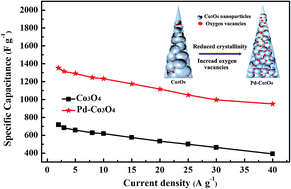A low crystallinity oxygen-vacancy-rich Co3O4 cathode for high-performance flexible asymmetric supercapacitors†
Abstract
Co3O4 has received ever-growing interest as an electro-active material for supercapacitors due to its high theoretical specific capacitance (3560 F g−1) and simple synthesis process. However, the intrinsically poor conductivity and sluggish reaction kinetics lead to a low practical capacity. In this work, a type of low crystallinity oxygen-vacancy-rich Co3O4 cathode has been fabricated through the introduction of Pd2+ during the hydrothermal process. The results indicate that the introduction of Pd can cause a disordered lattice orientation of Co3O4 nanoparticles and lead to reduced crystallinity. Numerous lattice boundaries caused by the poor crystallinity can facilitate the infiltration of electrolyte and contribute to the generation of oxygen vacancies, resulting in enhanced redox reaction and improved conductivity. The Pd–Co3O4 electrode delivers a high specific capacitance of 1353 F g−1 (4.6 F cm−2, about 2 times the capacitance of pristine Co3O4) at a current density of 7 mA cm−2 and presents 95% capacitance retention after 5000 charge/discharge cycles. The aqueous flexible asymmetric supercapacitor (Pd–Co3O4//carbon cloth) exhibits an energy density of 4.7 mW h cm−3 at the power density of 7 mW cm−3. This study underscores the potential importance of incorporating low crystallinity and oxygen vacancies into transition metal oxides as a strategy for increasing the charge storage ability of redox-active electrode materials.



 Please wait while we load your content...
Please wait while we load your content...